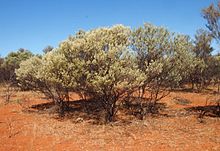Acacia cuthbertsonii
Appearance
| Acacia cuthbertsonii | |
|---|---|

| |
| Scientific classification | |
| Kingdom: | Plantae |
| Clade: | Tracheophytes |
| Clade: | Angiosperms |
| Clade: | Eudicots |
| Clade: | Rosids |
| Order: | Fabales |
| Family: | Fabaceae |
| Subfamily: | Caesalpinioideae |
| Clade: | Mimosoid clade |
| Genus: | Acacia |
| Species: | A. cuthbertsonii
|
| Binomial name | |
| Acacia cuthbertsonii | |

| |
| Range of Acacia cuthbertsonii | |
| Synonyms | |
|
Acacia cuthbertsoni Luehm.[2] | |
Acacia cuthbertsonii is a perennial shrub or tree native to arid parts of inland and northwestern Australia.[3]
Description
The shrub or tree typically grows to a height of 1 to 5 m (3 ft 3 in to 16 ft 5 in) and has a bushy and gnarled habit and has fissured, flaky bark. Like most species of Acacia it has
seed pods that form after flowering have a narrowly oblong to linear shape with a length of around 14 cm (5.5 in) and a width 11 to 22 mm (0.4 to 0.9 in) that dry to become yellowish and wrinkled. The dull, brown seeds within have a broadly elliptic to subcircular shape and are 7.5 to 9 mm (0.3 to 0.4 in) in length.[5]
Distribution
The species is found in drier areas of
gibber plains, and along creeks and drainage lines where it grows in stony sandy or loamy soils.[4]
Uses
The plant is used as an analgesic,[6] in particular, for headaches and toothaches,[7] by Aboriginal Australians of the Northern Territory. The wood is used to make splints to treat bone fractures.[8] Certain parts of the tree are used to make bandages.[9]
Subspecies
- Acacia cuthbertsonii subsp. cuthbertsonii
- Acacia cuthbertsonii subsp. linearis
See also
References
Wikispecies has information related to Acacia cuthbertsonii.
- . Retrieved 22 April 2024.
- ^ "ILDIS". International Legume Database & Information Service. Retrieved 27 August 2019.
- ^ "Acacia cuthbertsonii Luehm". Atlas of Living Australia. Global Biodiversity Information Facility. Archived from the original on 4 March 2016. Retrieved 27 August 2019.
- ^ Department of Biodiversity, Conservation and Attractions.
- ^ "Acacia cuthbertsonii". World Wide Wattle. Western Australian Herbarium. Retrieved 27 August 2019.
- ^ Analgesic Plants Archived April 23, 2007, at the Wayback Machine Australian New Crops Newsletter
- ^ Sydney Exotic Plants Archived 2007-09-28 at the Wayback Machine
- ^ ABRS Flora of Australia Online
- ISBN 978-0-85905-233-7.

